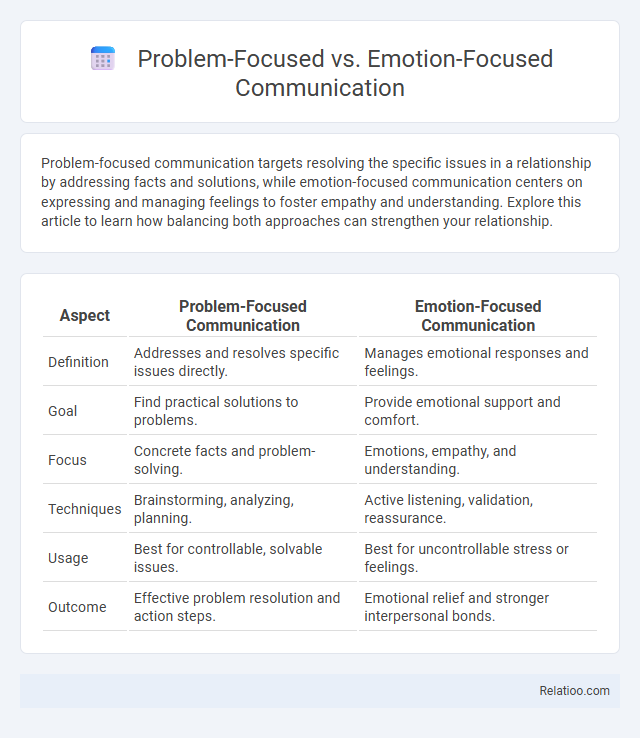Problem-focused communication targets resolving the specific issues in a relationship by addressing facts and solutions, while emotion-focused communication centers on expressing and managing feelings to foster empathy and understanding. Explore this article to learn how balancing both approaches can strengthen your relationship.
Table of Comparison
| Aspect | Problem-Focused Communication | Emotion-Focused Communication |
|---|---|---|
| Definition | Addresses and resolves specific issues directly. | Manages emotional responses and feelings. |
| Goal | Find practical solutions to problems. | Provide emotional support and comfort. |
| Focus | Concrete facts and problem-solving. | Emotions, empathy, and understanding. |
| Techniques | Brainstorming, analyzing, planning. | Active listening, validation, reassurance. |
| Usage | Best for controllable, solvable issues. | Best for uncontrollable stress or feelings. |
| Outcome | Effective problem resolution and action steps. | Emotional relief and stronger interpersonal bonds. |
Introduction to Communication Strategies
Problem-focused communication aims to directly address and resolve specific issues by analyzing facts and generating solutions, helping Your conversations become more goal-oriented and efficient. Emotion-focused communication centers on understanding, expressing, and managing feelings to provide emotional support and strengthen interpersonal connections. Mastering these communication strategies allows You to adapt your approach based on the context, balancing practical problem-solving with empathy and emotional awareness.
Defining Problem-focused Communication
Problem-focused communication involves directly addressing the issue at hand by identifying the problem, generating solutions, and taking actionable steps to resolve it. This approach prioritizes clarity, logical reasoning, and collaboration to effectively manage challenges and achieve desired outcomes. You can improve decision-making and conflict resolution by mastering problem-focused communication techniques.
Understanding Emotion-focused Communication
Emotion-focused communication centers on recognizing and validating feelings, helping your emotional needs during stressful situations. Unlike problem-focused communication, which targets finding solutions, emotion-focused strategies prioritize empathy, support, and emotional expression to foster connection. Understanding this form enhances your ability to navigate conflicts with compassion and strengthen interpersonal relationships effectively.
Key Differences Between Both Communication Styles
Problem-focused communication targets resolving the issue by identifying solutions and taking actionable steps, enhancing task efficiency and goal achievement. Emotion-focused communication centers on expressing feelings and managing emotional responses, fostering empathy and emotional support during stressful situations. The key difference lies in problem-focused communication aiming at practical resolution, while emotion-focused communication prioritizes emotional healing and interpersonal connection.
Benefits of Problem-focused Communication
Problem-focused communication effectively addresses specific issues by promoting clear problem-solving strategies, enhancing collaboration, and fostering practical solutions that improve outcomes. It encourages active engagement in identifying causes and implementing actionable steps, which boosts productivity and reduces misunderstandings. This type of communication is particularly beneficial in work environments where resolving challenges promptly and efficiently is crucial for success.
Advantages of Emotion-focused Communication
Emotion-focused communication enhances emotional well-being by allowing you to express and process feelings, which reduces stress and builds emotional resilience. This approach fosters deeper empathy and strengthens interpersonal relationships through active listening and emotional validation. By prioritizing emotional support, emotion-focused communication complements problem-solving efforts and promotes holistic mental health.
When to Use Problem-focused vs Emotion-focused Approaches
Problem-focused communication is most effective when the situation is controllable and requires solving specific issues, such as decision-making or conflict resolution. Emotion-focused communication is beneficial when the problem is uncontrollable or when providing emotional support is essential, like during grief or stress. Choosing between problem-focused and emotion-focused approaches depends on assessing the context's demands and the communicator's goals for either action or emotional relief.
Common Misunderstandings in Communication
Problem-focused communication targets resolving issues directly by identifying solutions, while emotion-focused communication prioritizes expressing and managing feelings related to the problem. A common misunderstanding is assuming that addressing emotions means avoiding the problem or that focusing solely on solutions neglects emotional well-being. Your ability to balance these approaches enhances clarity and empathy, preventing miscommunication and fostering effective interpersonal connections.
Enhancing Interpersonal Relationships
Problem-focused communication emphasizes identifying and resolving specific issues, fostering clear and practical dialogue that strengthens your ability to collaborate and find solutions. Emotion-focused communication centers on expressing and managing feelings, promoting empathy and emotional support which deepens trust and connection in relationships. Balancing problem-focused strategies with emotion-focused techniques enhances interpersonal relationships by addressing both practical challenges and emotional needs effectively.
Tips for Balancing Problem and Emotion-focused Communication
Balancing problem-focused and emotion-focused communication requires recognizing when to address practical solutions versus providing emotional support. Use clear, solution-oriented language to tackle issues directly, while validating feelings to foster empathy and trust. Effective communication integrates specific problem-solving strategies with active listening and emotional acknowledgment to maintain relational harmony.

Infographic: Problem-focused vs Emotion-focused Communication
 relatioo.com
relatioo.com